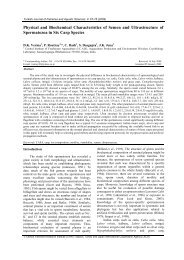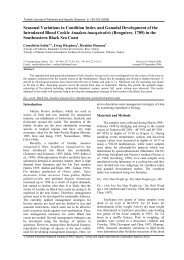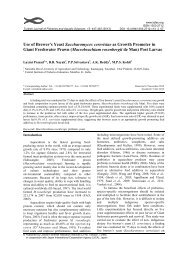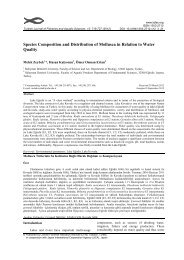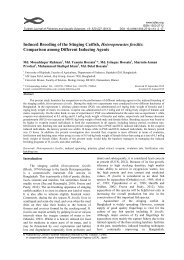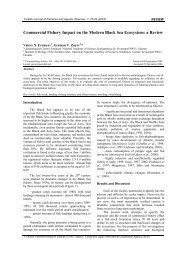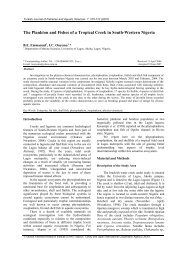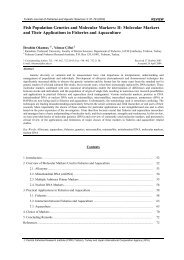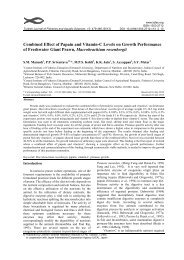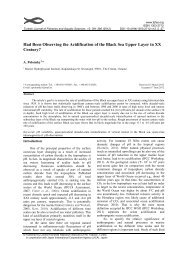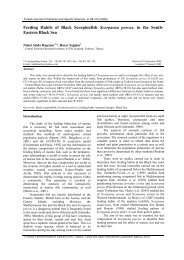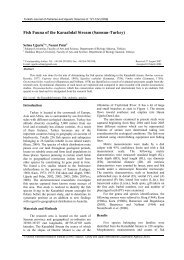Length Weight Relationship and Condition Factor of Giant ...
Length Weight Relationship and Condition Factor of Giant ...
Length Weight Relationship and Condition Factor of Giant ...
You also want an ePaper? Increase the reach of your titles
YUMPU automatically turns print PDFs into web optimized ePapers that Google loves.
Turkish Journal <strong>of</strong> Fisheries <strong>and</strong> Aquatic Sciences 12: 917-924 (2012)www.trjfas.orgISSN 1303-2712DOI: 10.4194/1303-2712-v12_4_19<strong>Length</strong> <strong>Weight</strong> <strong>Relationship</strong> <strong>and</strong> <strong>Condition</strong> <strong>Factor</strong> <strong>of</strong> <strong>Giant</strong> FreshwaterPrawn Macrobrachium rosenbergii (De Man, 1879) Based on DevelopmentalStages, Culture Stages <strong>and</strong> SexP.L. Lalrinsanga 1, *, Bindu R. Pillai 1 , Gunamaya Patra 1 , Swagatika Mohanty 1 ,Namita Kumari Naik 1 , Sovan Sahu 11 Central Institute <strong>of</strong> Freshwater Aquaculture, Kausalyaganga, Bhubaneswar, Orissa -751002, India.* Corresponding Author: Tel.: +91.674 2465446; Fax: +91.674 2465446;E-mail: viensky2@gmail.comReceived 01 July 2012Accepted 01 November 2012Abstract<strong>Length</strong>-weight relationship <strong>and</strong> condition factor <strong>of</strong> Macrobrachium rosenbergii (De Man, 1879) were investigated fordifferent culture phases, developmental stages <strong>and</strong> sexes in the present study. Regression lines differed among the culturephases, developmental stages as well as between sexes. Significant difference in the slope was observed among differentculture phases with nursery animals showing significantly lower slope. The most significant variation in the slope wasobserved among different developmental stages. Sex wise comparison also exhibit highly significant variation between male<strong>and</strong> female. Therefore, separate interconversional equations were derived for different culture phases, developmental stages<strong>and</strong> sexes to simplify management during culture. Additionally, condition factor was also found to be varying significantlybetween different culture phases, developmental stages <strong>and</strong> between sexes.Keywords: <strong>Length</strong> weight, condition factor, Macrobrachium rosenbergii, freshwater prawnIntroduction<strong>Length</strong>-weight relationship has vital importancein fisheries science. It helps in establishingmathematical relationship between the two variables,enables conversion <strong>of</strong> one variable to other (Le Cren,1951), to describe growth in the wild (Enin, 1994;Abohweyere <strong>and</strong> Williams, 2008; Deekae <strong>and</strong>Abowee, 2010), to determine possible differencesamong different stocks <strong>of</strong> the same species (Petrakis<strong>and</strong> Stergiou, 1995; King, 2007), delineate the stocks<strong>and</strong> comparative growth studies (Sampaio <strong>and</strong>Valenti, 1996; Primavera et al., 1998; Peixoto et al.,2004). Although shrimp body weight is commonlyrecorded for culture management purposes (e.g.estimations <strong>of</strong> growth rate, feed conversion ratio,harvest weight, <strong>and</strong> productivity), the application <strong>of</strong>morphometric relationships could be a simplealternative to estimate body weight from lengthmeasurements that are less variable <strong>and</strong> more easilymeasured in the field (Cheng <strong>and</strong> Chen, 1990;Primavera et al., 1998). Therefore, the use <strong>of</strong>morphometric measurements <strong>and</strong> mathematicalmodels in aquaculture is highly encouraged becausethat is the most precise <strong>and</strong> complete way <strong>of</strong>analyzing growth data (Hopkins, 1992).The condition factor (K) is an index reflectinginteractions between biotic <strong>and</strong> abiotic factors in thephysiological condition <strong>of</strong> the fishes. It shows thewell-being <strong>of</strong> the population during various life cyclestages <strong>and</strong> assessments <strong>of</strong> fish condition based onweight at a given length are thought to be reliableindicators <strong>of</strong> the energetic condition or energyreserves in fish (Lambert <strong>and</strong> Dutil, 1997). Althoughcondition factor indicates the general body conditionbut not the qualitative characteristics (protein, lipid,carbohydrates, etc.) <strong>of</strong> the body (Lalrinsanga et al.,2012), the body condition could be a usefulcomplement to expensive in vitro proximatecomposition analysis (Sutton et al. 2000).Morphometric relationships <strong>of</strong> length <strong>and</strong> weighthave been determined mainly in adult <strong>of</strong> severalMacrobrachium species (Jayach<strong>and</strong>ran <strong>and</strong> Joseph,1988; Enin, 1994; Abohweyere <strong>and</strong> Williams, 2008;Deekae <strong>and</strong> Abowee, 2010). <strong>Relationship</strong>s that allowinterconversions among the various length <strong>and</strong> weightparameters are needed e.g., to compare growthparameters (Dall et al., 1990) especially forcommercially important species like the giantfreshwater prawn Macrobrachium rosenbergii (DeMan, 1879). However report on morphometricanalysis <strong>of</strong> M. rosenbergii is limited (Sampaio <strong>and</strong>Valenti, 1996; Kurup et al. 2000; Kunda et al. 2008).Further there is a need to investigate length–weight© Published by Central Fisheries Research Institute (CFRI) Trabzon, Turkeyin cooperation with Japan International Cooperation Agency (JICA), Japan
918 P.L. Lalrinsanga et al. / Turk. J. Fish. Aquat. Sci. 12: 917-924 (2012)relationships at a wider size range, in order todetermine how the relationships change with size orlife stage <strong>and</strong> between sexes (Chow <strong>and</strong> S<strong>and</strong>ifer,1991). Therefore, the present work was undertaken toanalyze length-weight relationship <strong>and</strong> conditionfactor for separate sexes <strong>of</strong> M. rosenbergii <strong>of</strong> a widesize range, cultured in Central Institute <strong>of</strong> FreshwaterAquaculture (CIFA), Kausalyaganga, India underdifferent conditions during nursery, growout, <strong>and</strong>broodstock production phases. The knowledge mayprovide a basis for the establishment <strong>of</strong> a practicalconversion protocol to simplify management practicesin the different culture phases <strong>of</strong> the species.Materials <strong>and</strong> MethodsThe length <strong>and</strong> weight data <strong>of</strong> M. rosenbergiisamples individuals were obtained during stocking ortermination <strong>of</strong> various studies conducted at theCentral Institute <strong>of</strong> Freshwater Aquaculture (CIFA),Prawn breeding <strong>and</strong> culture unit, Kausalyaganga,Orissa, India from 2008 to 2010. Data were collectedfrom three different culture phases: nursery (2months), grow out (8-10 months), <strong>and</strong> broodstockproduction (>10 months). Total length (TL) wasmeasured to the nearest 0.1 mm using a 30-cm rulerfor nursery, growout <strong>and</strong> broodstock animals, as thedistance from the tip <strong>of</strong> the rostrum to the tip <strong>of</strong> thetelson. Analytical balances with precision <strong>of</strong> 0.01 gwere used to record body weight (BW). Approximatesize ranges were (a) nursery: 4-10 cm TL, (b).growout: 6–23 cm TL, <strong>and</strong> (c) broodstock: 11–29 cmTL.Nursery animals were excluded <strong>and</strong> only growout<strong>and</strong> broodstock animals were considered forcomparative analysis <strong>of</strong> developmental stages <strong>and</strong>sexes in order to enhance precision over manualsegregation <strong>of</strong> sex <strong>and</strong> stages. Sex was determined bychecking the external genital organs <strong>and</strong> ovarianmaturation stages were evaluated according to thecriteria proposed by Kuris et al. (1987) <strong>and</strong> Sagi <strong>and</strong>Ra'anan (1985). Males were segregated to fourdevelopmental morphotypes as blue claw (BC),orange claw (OC), small males (SM) <strong>and</strong> no claw(NC); while females were divided as berried,maturing <strong>and</strong> immatured. Animals <strong>of</strong> different sizeswere taken at r<strong>and</strong>om for both males <strong>and</strong> females <strong>and</strong>considered for analysis.The length–weight (log-transformed)relationships were determined by regression analysis<strong>and</strong> analysis <strong>of</strong> covariance was performed todetermine variation in „b‟ values within a givencategory (by developmental stages, culture stages <strong>and</strong>sex) following Snedecor <strong>and</strong> Cochran (1967). In orderto test “b” value against the isometric value <strong>of</strong> “3”,student‟s t-test was employed to predict anysignificant deviation. The t-statistic was calculated asfollows:t = (b-3)/Sbwhere, Sb= St<strong>and</strong>ard error <strong>of</strong> „b‟ = Sb = “(1/(n-2))*[(Sy/Sx)2-b2], Sx <strong>and</strong> Sy are the st<strong>and</strong>arddeviations <strong>of</strong> x <strong>and</strong> y respectively.Fulton‟s condition factor (K) for each individualwas calculated according to Htun-Han (1978)equation K =100×(W/L 3 ), where W is the bodyweight (BW), <strong>and</strong> L, the total length (TL).ResultsThe values for elevation (a) <strong>and</strong> slope (b)together with their corresponding regressioncoefficient (r 2 ) for the length–weight relationships inM. rosenbergii <strong>of</strong> different developmental stages,culture stages, sources <strong>and</strong> sexes are presented inTable 1. The relationships vary with developmentalstages, culture stages <strong>and</strong> sexes such that differentequations have to be used for purposes <strong>of</strong>interconversions.Culture PhasesNursery juveniles showed significantly lowervalues <strong>of</strong> b (Table 1), indicating lower weight gainrelative to increase in length compared to growout<strong>and</strong> broodstock animals. The growth in nurseryshowed isometry where as it is positive allometry ingrowout as well as broodstock animals. Although theslope in growout is found higher than broodstock, nosignificant difference was observed between growout<strong>and</strong> broodstock animals. Scatter diagrams <strong>of</strong> length<strong>and</strong> weight for different culture phases exhibitedcurvilinear relationship are shown in Figure 1.Developmental StagesComparative analysis <strong>of</strong> different developmentalstages showed significant variation in the slope (Table1). Among different stages <strong>of</strong> male developmentalstages, highest slope was observed for OC malecompared to NC, SM <strong>and</strong> BC, indicating higherweight gain relative to per unit changes in length. Theslope in NC animals is however found higher,meaning a greater increase in weight per unit increasein length compared to SM <strong>and</strong> BC animals. The slopein OC <strong>and</strong> NC is significantly higher than criticalisometric value indicating positive allometric growthwhereas it is isometric in SM <strong>and</strong> BC. In the case <strong>of</strong>female, no significant variation was observed betweendifferent stages <strong>of</strong> life. However, immature femalesshowed lowest slope, indicating lower weight gainrelative to per unit increase in length compared toberried <strong>and</strong> maturing females.SexSex wise comparison was carried out by takingdifferent size animals at r<strong>and</strong>om <strong>and</strong> segregating male<strong>and</strong> female from growout <strong>and</strong> broodstock animals.Scatter diagrams <strong>of</strong> length <strong>and</strong> weight for male,
Body weight (g)Body weight (g)Body weight (g)P.L. Lalrinsanga et al. / Turk. J. Fish. Aquat. Sci. 12: 917-924 (2012) 919Table 1. <strong>Length</strong> – weight relationship parameters, condition factor (K) <strong>and</strong> growth pattern <strong>of</strong> M. rosenbergii based ondevelopmental stages, culture stages <strong>and</strong> sexParticulars n Log a a CI 95% b± SE b CI 95% r 2 (K) pattern<strong>Condition</strong> factor GrowthCulture stageNursery 278 -2.0570 -2.1287 to -1.9610 2.9506±0.109 a 2.8211 - 3.0313 0.7239 0.7973±0.1251 a IsometryGrowout 387 -2.3344 -2.3911 to -2.2776 3.2944±0.025 b 3.2444 - 3.3443 0.9776 1.0049±0.1324 a + allometryBroodstock 342 -2.2855 -2.4602 to -2.1108 3.2667±0.071 b 3.1270 - 3.4063 0.8602 1.1451±0.2657 a + allometryDevelopmental stagesFemaleBerried 84 -2.2069 -2.4214 to -1.9922 3.2086±0.091 a 3.0280 - 3.3891 0.9384 1.1060±0.1344 a + allometryMaturing 202 -2.2257 -2.3759 to -2.0754 3.2046±0.063 a 3.0813 - 3.3278 0.9293 1.0639±0.1372 a + allometryImmatured 174 -2.2589 -2.3404 to -2.1774 3.1218±0.036 a 3.1502 - 3.2933 0.9787 0.9989±0.1434 a + allometryMaleBlue claw 70 -1.8079 -2.3543 to -1.2614 2.9551±0.214 a 2.5287 - 3.3813 0.7378 1.4076±0.4583 a IsometryOrange claw 95 -2.5427 -2.7849 to -2.3005 3.4809±0.099 b 3.2828 - 3.6790 0.9290 1.1186±0.1533 b + allometrySmall male 75 -2.1374 -2.3232 to -1.9515 3.0938±0.088 a 2.9192 - 3.2683 0.9447 0.9224±0.1022 b IsometryNo Claw 33 -2.3185 -2.6445 to -1.9925 3.2774±0.134 b 3.0036 - 3.5512 0.9506 1.0326±0.1140 b + allometrySexMale 273 -2.6132 -2.7180 to -2.5076 3.5502±0.045 a 3.4617 - 3.6386 0.9584 1.1435±0.3379 a + allometryFemale 460 -2.2734 -2.3362 to -2.2106 3.2443±0.027 b 3.1912 - 3.2973 0.9693 1.0470±0.1446 a + allometrySex pooled 2.6132 -2.4339 -2.4923 to -2.3754 3.3893±0.025 b 3.3401 - 3.4385 0.9615 1.0829±0.2402 a + allometryn: sample size; Log a: Log intercept; b±SE: slope±st<strong>and</strong>ard error; CI: confidence Interval; r 2 : coefficient <strong>of</strong> determination.Values with different superscripts in a column for culture stages, developmental stages <strong>and</strong> sex differ significantly (P < 0.05).Nursery (juvenile) phase9876543210W = 0.127836L 2.9506r 2 = 0.9159n = 2780 2 4 6 8 10Total length (cm)Growout phase250200150W = 0.096868L 3.2944r 2 = 0.9552n = 3871005000 5 10 15 20 25Broodstock phase250200150W = 0.101723L 3.2667r 2 = 0.8894n = 342Total length (cm)1005000 5 10 15 20 25 30Total length (cm)Figure 1. Scatter diagram showing length-weight relationship <strong>of</strong> M. rosenbergii during different culture phases.
Body weight (g)Body weight (g)Body weight (g)920 P.L. Lalrinsanga et al. / Turk. J. Fish. Aquat. Sci. 12: 917-924 (2012)female <strong>and</strong> pooled sexes exhibited curvilinearrelationship are shown in Figure 2. Significantlyhigher slope was observed in male compared t<strong>of</strong>emale (Table 1). The slope was found to besignificantly varying from critical isometric valueindicating high positive allometric growth in male,female <strong>and</strong> pooled sex.<strong>Condition</strong> <strong>Factor</strong> (K)The condition factor obtained in the presentstudy ranges from 0.79±0.13 in nursery animals to1.41±0.46 in BC animals (Table 1). No significantvariation was observed in K <strong>of</strong> different culture stageswith broodstock animal showing the highest followedby growout animals <strong>and</strong> nursery animals.Based on developmental stages, the K was foundhighest in BC compared to all other malemorphotypes. The K in OC was also found to behigher than SM although it did not vary significantly.In case <strong>of</strong> female, K in immatured female was foundto be lower compared to berried <strong>and</strong> maturing female(Table 1).Sex wise comparison revealed no significantvariation between male <strong>and</strong> female, although malewas found to exhibit higher K than female.DiscussionGenerally shellfish maintains dimensionalequality, the weight increase will be proportional tothe cube <strong>of</strong> length increment while the slope valueless than 3 indicates that the animal becomes slenderas it increases in length whereas slope greater than 3denotes stoutness indicating allometric growth200150W = 0.102962L 3.2443r 2 = 0.947n = 4601005000 5 10 15 20 25Total length (cm)Female250200150W = 0.073299L 3.5502r 2 = 0.9491n = 2731005000 5 10 15 20 25Total length (cm)Male250200150W = 0.087694L 3.3893r 2 = 0.9478n = 7331005000 5 10 15 20 25Total length (cm)TotalFigure 2. Scatter diagram showing sex wise length-weight relationship <strong>of</strong> M. Rosenbergii.
P.L. Lalrinsanga et al. / Turk. J. Fish. Aquat. Sci. 12: 917-924 (2012) 921(Grover <strong>and</strong> Juliano, 1976; Kurup et al., 2000).Variations in the slope (b) value <strong>of</strong> regression havebeen reported in several Macrobrachium speciesunder natural environment based on total length-bodyweight relationship (Enin, 1994; Abohweyere <strong>and</strong>Williams, 2008; Deekae <strong>and</strong> Abowei, 2010), which isattributed to sample size variation, life stages, <strong>and</strong>environmental factors. Nevertheless, few studies havedealt on how these relationships change with lifestages, size <strong>and</strong> sex under culture conditions in M.rosenbergii.The use <strong>of</strong> total length to determine length–weight morphometric relationships has been widelyapplied for wild <strong>and</strong> captive Macrobrachium species(Sampaio <strong>and</strong> Valenti, 1996; Anger <strong>and</strong> Moreira,1998; Kunda et al. 2008) as well as other penaeids(Cheng <strong>and</strong> Chen, 1990; Chow <strong>and</strong> S<strong>and</strong>ifer, 1991;Chu et al., 1995; Primavera et al., 1998). Hence, totallength is used to determine the length-weightrelationship in the current study. The parameters <strong>of</strong>the length–weight relationships estimated in thepresent study are well within the ranges previouslyreported for several Macrobrachium species (Enin,1994; Abohweyere <strong>and</strong> Williams, 2008; Deekae <strong>and</strong>Abowei, 2010). Kunda et al. (2008) reportedisometric growth (b=3.075) <strong>of</strong> M. rosenbergii in ricefield with co-efficient <strong>of</strong> determination (r2) <strong>of</strong> 0.99.Under culture environment, Sampaio <strong>and</strong> Valenti(1996) also observed high b value <strong>of</strong> 3.43 (positiveallometry) for M. rosenbergii, indicating rapid growth<strong>of</strong> the species.Culture StagesThe growth rate <strong>of</strong> animals varies widelydepending on the culture stages <strong>and</strong> developmentalstages such that younger <strong>and</strong> smaller nursery juvenilesgrow faster than older <strong>and</strong> bigger animals (Primaveraet al., 1998). In contrast the slope <strong>of</strong> nursery animals,although follows isometric growth pattern, was foundsignificantly lower compared to grow out <strong>and</strong>broodstock animals (P
922 P.L. Lalrinsanga et al. / Turk. J. Fish. Aquat. Sci. 12: 917-924 (2012)compared to female (P
P.L. Lalrinsanga et al. / Turk. J. Fish. Aquat. Sci. 12: 917-924 (2012) 923Production <strong>and</strong> Environment Division, CIFA for hiskeen interest <strong>and</strong> support in carrying out this work.ReferencesAbohweyere, P.O. <strong>and</strong> Williams, A.B. 2008. <strong>Length</strong>-weightrelationship <strong>and</strong> condition factor <strong>of</strong> Macrobrachiummacrobrachion in the Lagos-Lekki Lagoon system,Nigeria. Res. J. Biol. Sci., 3(11): 1333-1336.Anger, K., Moreira, G.S. 1998. Morphometric <strong>and</strong>reproductive traits <strong>of</strong> tropical caridean shrimps. J.Crustacean Biol. 18(4): 823-838.Araneda, M., Pérez, E.P. <strong>and</strong> Gasca-Leyva, E. 2008. Whiteshrimp Penaeus vannamei culture in freshwater atthree densities: <strong>Condition</strong> state based on length <strong>and</strong>weight. Aquaculture, 283: 13–18.Arimoro, F.O. <strong>and</strong> Meye, J.A. 2007. Some aspects <strong>of</strong> thebiology <strong>of</strong> Macrobrachium dux (lenz, 1910)(crustacea: decapoda: natantia) in river Orogodo,Niger delta, Nigeria. Acta Biol. Colomb., 12(1): 111 –122.Cheng, C.S. <strong>and</strong> Chen, L. 1990. Growth characteristics <strong>and</strong>relationships among body length, body weight <strong>and</strong> tailweight <strong>of</strong> Penaeus monodon from a cultureenvironment in Taiwan. Aquaculture, 91: 253–263.Chow, S. <strong>and</strong> S<strong>and</strong>ifer, P.A. 1991. Differences in growth,morphometric traits, <strong>and</strong> male sexual maturity amongPacific white shrimp, Penaeus vannamei, fromdifferent commercial hatcheries. Aquaculture 92:165–178.Chu, K.H., Chen, Q.C., Huang, L.M. <strong>and</strong> Wong, C.K. 1995.Morphometric analysis <strong>of</strong> commercially importantpenaeid shrimps from the Zhujiang estuary, China.Fish. Res., 23: 83-93.Crocos, P.J. <strong>and</strong> Kerr, J.D. 1983. Maturation <strong>and</strong> spawning<strong>of</strong> the banana prawn Penaeus merguiensis De Man(Crustacea: Penaeidae) in the Gulf <strong>of</strong> Carpentaria,Australia. J. Exp. Mar. Biol. Ecol., 69: 37-59.Dall, W., Hill, B.J., Rothlisberg, P.C. <strong>and</strong> Sharples. D.J.1990. The biology <strong>of</strong> the Penaeidae.-Advances inmarine biology, Academic Press, London, 27: 1-489.Daud, S.K. <strong>and</strong> Ang, K.J. 1995. Selection <strong>of</strong> broodstock <strong>of</strong>tiger prawn, Penaeus monodon Fabricus, on the basis<strong>of</strong> morphometric traits. Pertanika J. Trop. Agri. Sci.,18(1): 15-20.Deekae, S.N. <strong>and</strong> Abowei, J.F.N. 2010. Macrobrachiummacrobrachion (Herklots, 1851) length-weightrelationship <strong>and</strong> Fulton‟s condition factor in Luubaracreek, Ogoni l<strong>and</strong>, Niger delta, Nigeria. Inter. J. Ani.Vet. Adv., 2(4): 155-162.Enin, U. 1994. <strong>Length</strong>–weight parameters <strong>and</strong> conditionfactor <strong>of</strong> two West African prawns. Rev. Hydrobiol.Trop., 27: 121–127.Farmer, A.S.D. 1986. Morphometric relationships <strong>of</strong>commercially important species <strong>of</strong> penaeid shrimpfrom the Arabian Gulf. Kuwait Bull. Mar. Sci., 7: l-21.Fransozo, A., Rodrigues, F.D., Freire, F.A.M. <strong>and</strong> Costa,R.C. 2004. Reproductive biology <strong>of</strong> the freshwaterprawn Macrobrachium iheringi (Ortmann, 1897)(Decapoda: Caridea: Palaemonidae) in the Botucaturegion, São Paulo, Brazil. Nauplius, 12:119-126.Grover, H. John <strong>and</strong> Juliano, R.O. 1976. <strong>Length</strong>-weightrelationship <strong>of</strong> pond-raised milkfish in the Philippines.Aquaculture, 7: 339-346.Hansford, S.W. <strong>and</strong> Hewitt, D.R. 1994. Growth <strong>and</strong> nutrientdigestibility by male <strong>and</strong> female Penaeus monodon:Evidence <strong>of</strong> sexual dimorphism. Aquaculture, 125:147–154.Hopkins, K.D. 1992. Reporting fish growth: a review <strong>of</strong> thebasics. J. World Aqua. Soc., 23: 173-179.Htun-Han, M. 1978. The reproductive biology <strong>of</strong> the dabLim<strong>and</strong>a limanada (L.) in the north Sea:gonadosomatic index, hepatosomatic index <strong>and</strong>condition factor. J. Fish Biol., 13(1): 351-377.Jayach<strong>and</strong>ran, K.V. <strong>and</strong> Joseph, N.I. 1988. Growth patternin the slender river prawn, Macrobrachium idella(Hilgendarf). Mahasagar, 21(3): 189-195.King, M. 2007. Fisheries biology, assessment <strong>and</strong>management. Second Edition. Blackwell ScientificPublications, Oxford, 1-381.Kunda, M., Dewan, S., Uddin, M.J., Karim, M., Kabir, S.<strong>and</strong> Uddin, M.S. 2008. <strong>Length</strong>-<strong>Weight</strong> relationship,condition factor <strong>and</strong> relative condition factor <strong>of</strong>Macrobrachium rosenbergii in rice fields. Asian Fish.Sc., 21: 451-456.Kuris, A.M., Ra‟anan, Z., Sagi, A. <strong>and</strong> Cohen, D. 1987.Morphotypic differentiation <strong>of</strong> male Malaysian giantprawn, Macrobrachiurn rosenbergii. J. CrustaceanBiol. 72: 19-237.Kurup, B.M., Harikrishnan, M. <strong>and</strong> Sureshkumar, S. 2000.<strong>Length</strong>-weight relationship <strong>of</strong> male morphotypes <strong>of</strong>Macrobrachium rosenbergii (de Man) as a valid indexfor differentiating their developmental pathway <strong>and</strong>growth phases. Indian J. Fish., 47(4): 283-290.Kuun, P., Pakhomov, E.A. <strong>and</strong> McQuaid, C.D. 1999.Morphometric relationship <strong>of</strong> caridean shrimp,Nauticaris marionis Bate, 1988 at the Prince EdwardIsl<strong>and</strong>s (Southern Ocean). Polar Biol., 22: 216–218.Lalrinsanga, P.L., Pillai, B.R., Mahapatra, K.D., Sahoo, L.,Ponzoni, R.W., Nguyen, N.H., Mohanty, S., Sahu, S.,Sahu, S., Kumar, V., Patra, G. <strong>and</strong> Patnaik, S. 2012.<strong>Length</strong>–weight relationship <strong>and</strong> condition factor <strong>of</strong>nine possible crosses <strong>of</strong> three stocks <strong>of</strong> giantfreshwater prawn, Macrobrachium rosenbergii fromdifferent agro-ecological regions <strong>of</strong> India. AquacultInt, DOI 10.1007/s10499-012-9595-4.Lambert, Y. <strong>and</strong> Dutil, J.D. 1997. Can simple conditionindices be used to monitor <strong>and</strong> quantify seasonalchanges in the energy reserves <strong>of</strong> Atlantic cod (Gadusmorhua)? Can. J. Fish. Aquat. Sci., 54(1): 104-112.Le Cren, E.D. 1951. The length-weight relationships <strong>and</strong>seasonal cycle in gonad weight <strong>and</strong> condition in theperch (Perca fluviatilis). J. Ani. Ecol., 20: 201-219.Makinouchi, S. <strong>and</strong> Hirata, H. 1995. Studies on maturation<strong>and</strong> reproduction <strong>of</strong> pond-reared Penaeus monodonfor developing a closed life-cycle culture system.Israeli J. Aqua. Bamid., 47: 68–77.Mantelatto, F.L.M. <strong>and</strong> Barbosa, L.R. 2005. Populationstructure <strong>and</strong> relative growth <strong>of</strong> freshwater prawnMacrobrachium brasiliense (Decapoda,Palaemonidae) from São Paulo State, Brazil. ActaLimnol. Bras., 17(3):245-255.Mossolin, E.C. <strong>and</strong> Bueno, S.L.S. 2003. Relative growth <strong>of</strong>the second pereiopod in Macrobrachium olfersi(Wiegmann, 1836) Decapoda, Palaemonidae).Crustaceana, 76: 363-376.Nagamine, C. <strong>and</strong> Knight, A.W. 1980. Development,maturation <strong>and</strong> function <strong>of</strong> some sexually dimorphicstructures <strong>of</strong> the Malaysian prawn, Macrobrachiumrosenbergii (de Man) (Decapoda, Palaemonidae).Crustaceana, 39: 141-152.Nwosu, F. M. <strong>and</strong> Wolfi, M. 2006. Population Dynamics <strong>of</strong>
924 P.L. Lalrinsanga et al. / Turk. J. Fish. Aquat. Sci. 12: 917-924 (2012)the <strong>Giant</strong> African River Prawn Macrobrachiumvollenhovenii Herklots 1857 (Crustacea,Palaemonidae) in the Cross River Estuary, Nigeria.West Africa J. Appl. Ecol., 9: 1-14.Peixoto, S., Cavalli, R.O., D‟Incao, F., Milach, A. <strong>and</strong>Wasielesky, W. 2003. Ovarian maturation <strong>of</strong> wildFarfantepenaeus paulensis in relation to histological<strong>and</strong> visual changes. Aqua. Res., 34: 1255–1260.Peixoto, S., Soares, R., Wasielesky, W., Cavalli, R.O. <strong>and</strong>Jensen, L. 2004. Morphometric relationship <strong>of</strong> weight<strong>and</strong> length <strong>of</strong> cultured Farfantepenaeus paulensisduring nursery, grow out, <strong>and</strong> broodstock productionphases. Aquaculture, 241: 291–299.Petrakis, G. <strong>and</strong> Stergiou, K.I. 1995. <strong>Weight</strong>-lengthrelationships for 33 fish species in Greek waters. Fish.Res., 21: 465-469.Primavera, J.H., Parado-Estepa, F.D. <strong>and</strong> Lebata, J.L. 1998.Morphometric relationship <strong>of</strong> length <strong>and</strong> weight <strong>of</strong>giant tiger prawn Penaeus monodon according to lifestage, sex <strong>and</strong> source. Aquaculture, 164: 67–75.Ra'anan, Z. <strong>and</strong> Sagi, A. 1985. Alternative mating strategiesin males <strong>of</strong> the freshwater prawn Macrobrachiumrosenhergii (de Man). Biol. Bull., 169: 592-601.Rajyalakshmi, T. 1980. Comparative study <strong>of</strong> the biology <strong>of</strong>the freshwater prawn Macrobrachium malcolmsonii<strong>of</strong> Godaveri <strong>and</strong> Hooghly river systems. Proc. IndiaNat. Acad. Sic., 46 (1): 72–89.Rao, R.M. 1967. Studies on the biology <strong>of</strong> Macrobrachiumrosenbergii (De Man) <strong>of</strong> the Hoogly estuary withnotes <strong>of</strong> its fishery. Proc. Nat. Inst. Sci. India. Part. B.Biol. Sci., 33: 252-279.Rhodes, C.P. <strong>and</strong> Holdich, M.H. 1984. <strong>Length</strong> weightrelationships, muscle production <strong>and</strong> proximatecomposition <strong>of</strong> the freshwater crayfish,Austropotamobius pallipes. Aquaculture 17: 345–358.Sagi, A. <strong>and</strong> Ra'anan, Z. 1985. Rapid identification <strong>of</strong>reproductive state <strong>and</strong> the receptive period <strong>of</strong> femalesin pond populations <strong>of</strong> Macrobrachium rosenbergii -a new technique. Aquaculture, 48: 361–367.Sagi, A. <strong>and</strong> Ra'anan, Z. 1988. Morphotypic differentiation<strong>of</strong> males <strong>of</strong> the freshwater prawn Macrobrachiumrosenhergii: Changes in the midgut gl<strong>and</strong>s <strong>and</strong>reproductive system. J. Crustacean Biol., 8(1): 43-47.Sampaio, C.M.S. <strong>and</strong> Valenti, W.C. 1996. Growth Curvesfor Macrobrachium rosenbergii in Semi-IntensiveCulture in Brazil. J. World Aqua Soc., 27 (3): 353-358.Snedecor, G.W. <strong>and</strong> Cochran, W.G. 1967. Statistica1methods (Oxford <strong>and</strong> IBH Publishing Co, New Delhi)1967, 539. pp.Sutton, S.G., Bult, T.P. <strong>and</strong> Haedrich, R.L. 2000.<strong>Relationship</strong>s among fat weight, body weight, waterweight, <strong>and</strong> condition factors in wild Atlantic salmonparr. Tran. American Fish. Soc., 129: 527–538.Tan-Fermin, J.D. <strong>and</strong> Pudadera, R.A. 1989. Ovarianmaturation stages <strong>of</strong> the wild giant tiger prawn,Penaeus monodon Fabricius. Aquaculture, 77: 229–242.Thanh, N.M., Ponzoni, R.W., Nguyen, N.H.,Vu, N.T.,Barnes, A. <strong>and</strong> Mather, P.B. 2009. Evaluation <strong>of</strong>growth performance ina diallel cross <strong>of</strong> three strains<strong>of</strong> giant freshwater prawn (Macrobrachiumrosenbergii) in Vietnam. Aquaculture 287: 75-83.Tzeng, T., Chiu, C. <strong>and</strong> Yeh, S., 2001. Morphometricvariation in red-spot prawn (Metapenaeopsis barbata)in different geographic waters <strong>of</strong>f Taiwan. Fish. Res.,53: 211-217.



